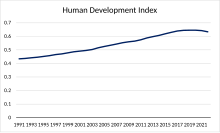Income inequality in India
The report calls for higher taxes on the wealthy, increased spending on health and education, and measures to address gender and social inequality.
[5][6][7] According to Union Government 's own submission to Supreme Court of India, widespread hunger has caused 65% of deaths of children under the age of 5 in 2022.
[10] According to Thomas Piketty, it is difficult to accurately measure wealth inequality in India because of large gaps in income tax data.
To address this growing inequality, the authors advocate for better access to official data and greater transparency in economic reporting.
They also recommend a comprehensive wealth tax on the ultra-rich, aimed at reducing extreme inequality while creating fiscal space for increased social sector investments.
N. C. Saxena, a member of the National Advisory Council, suggested that the widening income disparity can be accounted for by India's badly shaped agricultural and rural safety nets.
Rising income inequality makes it difficult for the poor to climb up the economic ladder and increases their risk of being victims to poverty trap.
[23] People living at the bottom 10% are characterized by low wages; long working hours; lack of basic services such as first aid, drinking water and sanitation.

